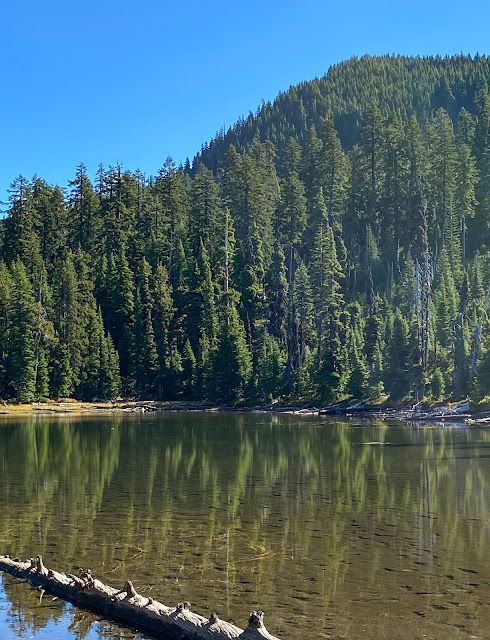As the crow flies, the O'Brien Creek Trail #900 is situated about 7.7 miles directly south of the town of Williams, Oregon. It is possible to begin hiking at the lower trailhead, or continue driving to the end of the Forest Road 1005 and begin at the Upper O'Brien Creek trailhead. Hiking both trails with a couple of short diversions, we logged 7.1 miles and an elevation gain of 2,303 feet. The lower trail closely follows O'Brien Creek although the best view (from the trail) on this stretch is right at the trailhead.
The lower trail winds through lush riparian habitat, and the tranquil sound of the water tumbling down the rocky mountainside is constant. The area burned in the 2017 Creedence Fire, which began with a lightning strike. The fire burned approximately 2,093 acres on both sides of the divide, including portions of O’Brien Creek.

Hydraulic mining occurred in this area during the late 19th century. According to a 1996 Department of the Interior publication (Stories on the Land: An Environmental History of the Applegate and Upper Illinois Valleys), O'Brien Creek water was diverted for mining via a ditch that is currently used to divert irrigation water to Thompson Creek. Some of the area around O'Brien Creek was reportedly harvested for timber in the 1950s. Forest Road 1005 which leads to O'Brien Creek was constructed in the late 1950s through the 1960s by timber purchasers (Rogue River-Siskiyou National Forest Roads Analysis 2004). The creek was reportedly named for John O'Brien, farmer and stock raiser born in Galway, Ireland. He apparently trailed cattle from his lower Applegate River ranch to the meadows in the Grayback Mountain-Sugarloaf Peaks area. John came to the region in 1852 and was said to have found a pocket of gold worth $28,000. He spent all of the money digging a 13 mile diversion ditch out of O'Brien Creek to work the deposit (Notes on Historical Events as related by Ranger Lee Port, Rogue River Historical Information, Applegate Ranger District, 1943).

According to an Applegate Watershed Assessment prepared by the Applegate River Watershed Council in 1994, O'Brien Creek and nearby Sturgis Creek were once widely-known as blue-ribbon trout streams; however, few large fish are present today. The report states that some populations of cutthroat are present in remote headwater areas. The upper trail continues along the creek until a split that leads to the Grayback Snow Shelter (a cabin that was used before snow surveys were automated). Take a right to continue on towards Boundary Trail.
At this point, the trail leaves the creek and winds up the slope toward the Grayback Mountain and the intersection of Upper O'Brien Creek trail, Boundary Trail and Grayback Mountain Trail.
The upper trail continues through the forested slope, passing through areas containing evidence of bears and examples of soil creep.
At the junction with the Boundary Trail, there is a sweeping view of the Grayback Mountain slopes with Mount McLoughlin in the distance. From this point, the trail will split toward Grayback Mountain Trail (to the north) and Boundary Trail (to the south), which is a 15.6 mile ridgeline trail that travels through high mountain meadows and divides the Illinois, Klamath, and Applegate drainages.























